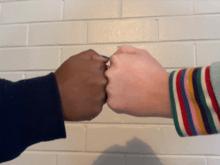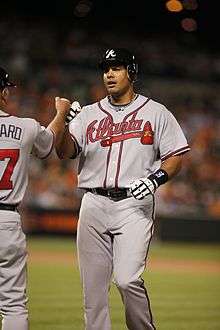Fist bump
A fist bump (also known as a bro fist,[1] power five, tater, PIB (as in pound it, bro), knucks, or pibbys[2]) is a gesture similar in meaning to a handshake or high five. A fist bump can also be a symbol of giving respect or approval, as well as companionship between two people. It can be followed by various other hand and body gestures (such as immediately opening the palm and spreading the fingers for “knucks with explosions”) and may be part of a dap greeting. It is commonly used in baseball and hockey as a form of celebration with teammates, and with opposition players at the end of a game. In cricket it is a common celebratory gesture between batting partners. Fist bumps are often given as a form of friendly congratulation.
.jpg)
Definition
A fist bump, according to Merriam-Webster, is a gesture in which two people bump their fists together (as in greeting or celebration).[3]
The gesture is performed when two participants each form a closed fist with one hand and then lightly tap the front of their fists together. A participant's fists may be either vertically oriented (perpendicular to the ground) or horizontally oriented. Unlike the standard handshake, which is typically performed only with each participant’s right hand, a fist bump may be performed with participants using either hand.

History

The "fist bump" or "pound" can be traced to boxers instructed to touch gloves at the start of a contest. Likewise, dart players bump fists that are clutching pointed mini-arrows. The modern gesture may have arisen spontaneously on city basketball courts, and was popularized by basketball player Fred Carter in the 1970s.[2][4]
Others trace the gesture to the Wonder Twins, minor characters in the 1970s Hanna-Barbera superhero cartoon Super Friends, who touched knuckles and cried "Wonder Twin powers, activate!"[2]
Baseball Hall of Famer Stan Musial used the fist bump during the 1950–60s as an alternative to shaking hands. Musial was convinced that he was catching too many colds by picking up germs while shaking thousands of hands each year, so he adopted the fist bump as a friendly alternative.[5]
Smithsonian researcher LaMont Hamilton suggests that the dap originated during the Vietnam War as a modified form of the Black Power salute, which was prohibited by the US military.[6]
Pat Benatar is seen giving another dancer a fist bump at the end of her 1983 video for the song "Love Is a Battlefield."
The fist bump was first seen in Australia in September 1990 at the Wetherill Park Indoor Cricket Centre between two opening batsmen, Mick Tyler and Bob Minney. At the completion of the first successful batting over for the pair, they met mid-pitch and fist bumped with their batting gloves. They continued to fist bump for the remainder of the game and it continued into the future. Now this act can be seen on various sporting fields/arenas around Australia, and it is now commonly practiced at an international level; many international cricketers fist bump in between overs or as congratulations after a six has been hit.[7]
In light of the 2009 H1N1 pandemic, the Dean of Medicine at the University of Calgary, Tom Feasby, suggested that the fist bump may be a "nice replacement of the handshake" in an effort to prevent transmission of the virus.[8] Similarly, a medical study has found that fist bumps and high fives spread fewer germs than handshakes.[9][10]
Fist bumping behavior has also been observed in chimpanzees, according to a book written by Margaret Power in 1991.[11]
Hygiene
Because of the reduced skin contact and resulting bacterial transfer, one study[12] has recommended that the fist bump and high five be adopted as a more hygienic alternative to the handshake.
References
- Steven J. Bennett. 365 Rules of the New World. Balboa Press. ISBN 9781504325851. Retrieved March 16, 2019.
- Stephey, M.J. (June 5, 2008). "A Brief History of the Fist Bump". Time magazine. Retrieved June 8, 2008.
- "fist bump | a gesture in which two people bump their fists together (as in greeting or celebration)". merriam-webster.com. Retrieved April 29, 2015.
- Kennedy, Pagan (October 26, 2012). "Who Made That Fist Bump?". The New York Times. ISSN 0362-4331. Retrieved August 15, 2019.
- Can high-fives and fist-bumps help teams win?, Stan Grossfeld, Boston Globe, 2015-12-26
- Hamilton, LaMont (September 22, 2014). "Five on the Black Hand Side: Origins and Evolutions of the Dap". Smithsonian Center for Folklife and Cultural Heritage. Retrieved September 13, 2016.
- Australian Folklore and Wetherill Park Sports Journal 4.21101990
- Fist bump can pound out flu transmission
- Los Angeles Times (July 28, 2014). "Fist bumps, high-fives spread fewer germs than handshakes, study says". latimes.com. Retrieved June 7, 2015.
- ABC News. "Health News & Articles – Healthy Living – ABC News". ABC News. Retrieved June 7, 2015.
- Power, Margaret (1991). The Egalitarians – Human and Chimpanzee: An Anthropological View of Social Organization. Cambridge University Press. ISBN 0-521-40016-3.
- Mela, Sara; Whitworth, David E. (August 1, 2014). "The fist bump: a more hygienic alternative to the handshake" (PDF). American Journal of Infection Control. 42 (8): 916–917. doi:10.1016/j.ajic.2014.04.011. ISSN 1527-3296. PMID 25087144.
Further reading
| Wikimedia Commons has media related to Fist bumps. |
| Look up fist bump in Wiktionary, the free dictionary. |
- Safire, William (July 6, 2008). "Fist Bump". The New York Times Magazine. Retrieved July 15, 2008.